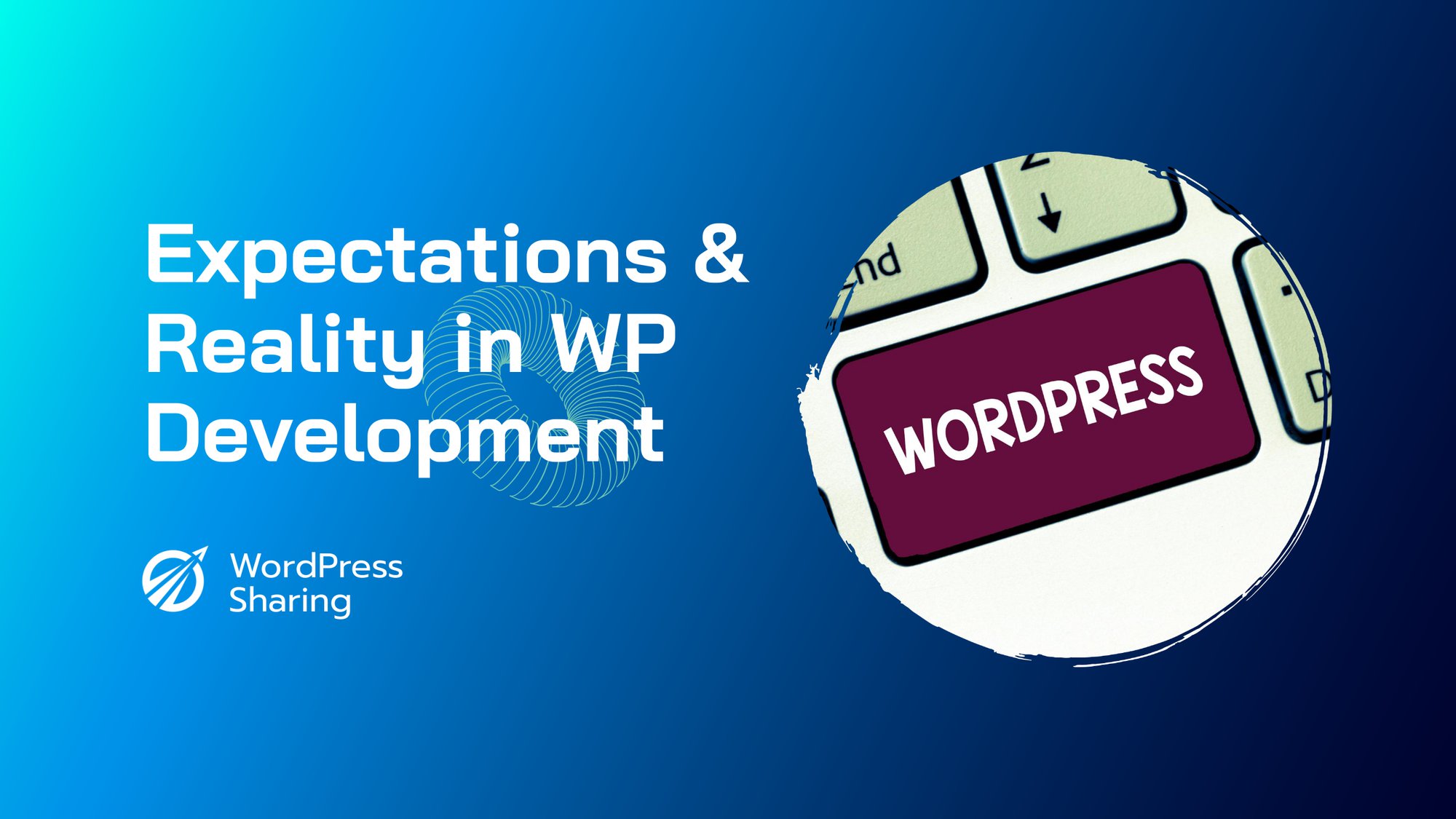What exactly is Open AI?
OpenAI is a San Francisco, California-based research facility. Its purpose is to ensure that all of mankind benefits from artificial general intelligence.
What exactly is ChatGPT?
Open AI’s language model is ChatGPT. ChatGPT-3.5 is the most recent version. ChatGPT (Generative Pre-trained Transformer) is an OpenAI chatbot that will be released in November 2022.
It is based on OpenAI’s GPT-3.5 family of big language models and is modified using supervised and reinforcement learning approaches.
Six Things You Should Know About ChatGPT
ChatGPT can create articles on almost any topic since it has been trained on a vast range of content that is freely available to the public.
However, there are several limitations to ChatGPT that you should be aware of before using it on an SEO project.
The most significant issue is that ChatGPT is unreliable in terms of producing correct information. Because the model simply predicts what words should come after the previous word in a phrase in a paragraph on a certain topic, it is erroneous. It is unconcerned with precision.
That should be a key priority for everyone interested in producing high-quality material.
1. Set up to avoid certain types of content
ChatGPT, for example, is specially configured not to create text about graphic violence, explicit sex, and potentially destructive information, such as instructions on how to assemble an explosive device.
2. Ignorant of Current Events
Another drawback is that it has no knowledge of any information generated after 2021.
So, if your material must be current and fresh, ChatGPT in its current form may be ineffective.
3. Has inherent biases
It is taught to be helpful, genuine, and harmless, which is an essential restriction to be aware of.
These aren’t merely ideas; they’re deliberate prejudices embedded into the mechanism.
It appears that the programming to be innocuous prevents the output from being negative.
That’s a positive thing, but it also gently shifts the piece away from being neutral.
In a sense, one must take the wheel and directly instruct ChatGPT to drive in the desired direction.
Here’s an illustration of how bias affects production.
I requested ChatGPT to create a tale in the Raymond Carver style and another in the Raymond Chandler style.
Both stories ended on a positive note, which was unusual for both authors.
To produce an output that met my expectations, I had to provide explicit instructions to ChatGPT to prevent cheery endings and for the Carver-style conclusion to avoid a closure to the tale, as that is how Raymond Carver’s works frequently played out.
The point is that ChatGPT contains biases, and one must be mindful of how these may affect the outcome.
4. ChatGPT Requires Extensive Instructions
ChatGPT requires particular instructions in order to produce higher-quality material that is more likely to be highly unique or take a certain point of view.
The more instructions supplied to it, the more complex the result.
This is a strength as well as a weakness to be mindful of.
The fewer instructions in the content request, the more likely the result will be comparable to that of another request.
As a test, I duplicated the query and result that several people discussed on Facebook.
When I asked ChatGPT the identical question, the computer generated an entirely unique essay with a similar structure.
The pieces were distinct, yet they had the same structure and addressed comparable subtopics, albeit in entirely different wording.
ChatGPT is supposed to anticipate the next word in an article using entirely random terms, therefore it seems reasonable that it does not plagiarize itself.
However, the fact that comparable queries result in similar articles emphasizes the limits of just requesting “give me this.”
5. Is it possible to identify ChatGPT content?
For many years, researchers at Google and other companies have worked on algorithms for accurately recognizing AI created material.
There are other study publications on the subject, and I’ll highlight one from March 2022 that employed GPT-2 and GPT-3 results.
Adversarial Robustness of Neural-Statistical Features in Detection of Generative Transformers is the title of the research study (PDF).
The researchers were experimenting to determine what type of analysis could discover AI-generated content that used methods meant to avoid detection.
They experimented with tactics such as employing BERT algorithms to replace words with synonyms and another that inserted misspellings, among others.
They observed that several statistical aspects of AI generated text, such as Gunning-Fog Index and Flesch Index scores, were beneficial for determining whether a text was generated by a computer, even if the method employed was supposed to avoid detection.
6. Hidden Watermarking
More importantly, OpenAI researchers have developed cryptographic watermarking that will help in the discovery of information published using an OpenAI product such as ChatGPT.
A recent article drew attention to a conversation by an OpenAI researcher, which is available on a video named Scott Aaronson Talks AI Safety.
According to the study, ethical AI methods such as watermarking can emerge into industry standards in the same way that Robots.txt became a norm for ethical crawling.
What ChatGPT-3 is capable of ?
ChatGPT is an OpenAI-developed big language model chatbot built on GPT-3.5. It has an amazing capacity to communicate in the form of a conversational dialogue and offer replies that can look quite human. The task of predicting the next word in a succession of words is performed by large language models.
Assume you give it a prompt, and it will complete the remainder of the material for you.
You may check out AI content generating here: https://chat.openai.com/chat
How can WordPress be utilized with ChatGPT-3 and Innovator AI?
I have created a WordPress plugin that uses Open AI and the ChatGPT-3 model to generate autonomous AI content for your site.
The name of the plugin is Innovator AI, and it is your virtual AI helper to make your WordPress content automation journey easy and beautiful by utilizing Open AI.
Let’s grab the link to the plugin: https://wordpress.org/plugins/innovator-ai/
Please install the plugin before continuing with the lesson.
Let’s look at a plugin demo to discover how this plugin may assist you produce automatic AI generated content for your blog.
Dashboard Page: From here, you may produce AI content from your content tip using the Try demo area.
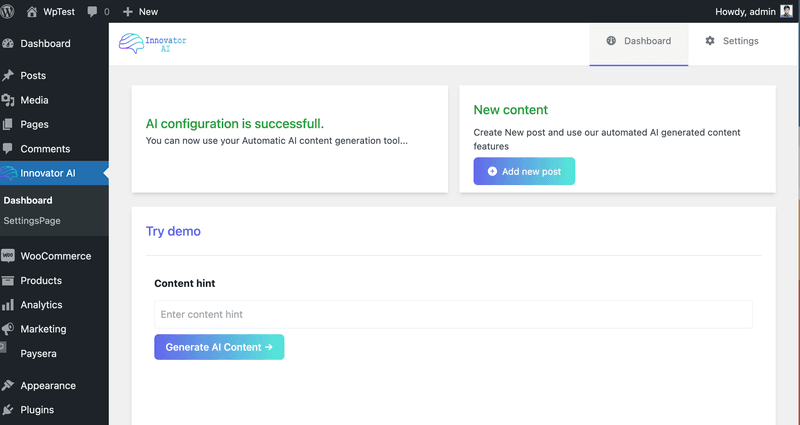
The Configuration Page
In settings, enter your Open AI API key obtained from this link: https://beta.openai.com/account/api-keys
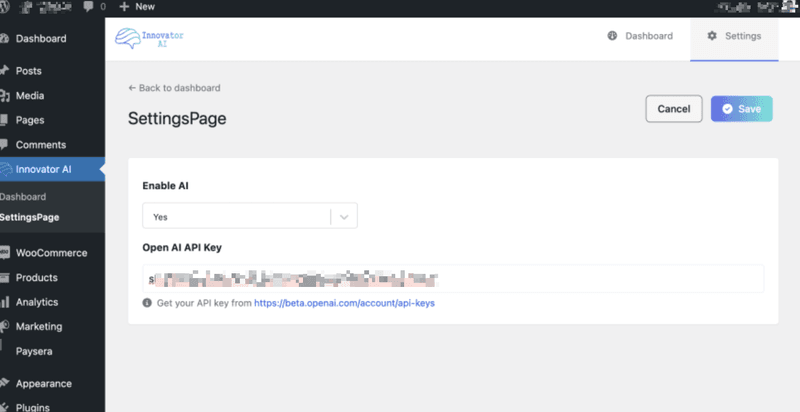
Pages and Posts
If you go to create post for your blog, you can simply discover our Text generator Block in the new Gutenberg editor by typing /text-generator.
Then, from the right side, you may provide your tip and produce material, which will be copied to your clipboard.
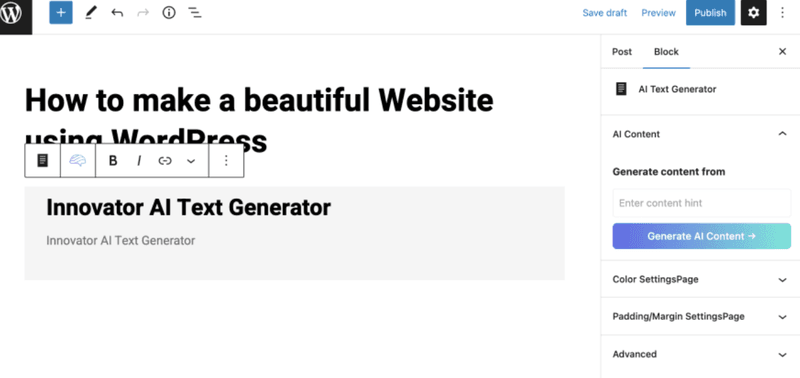
Toolbar Posting
You’ll find our content-generating support block AI content in every Gutenberg block toolbar.
When you click on the AI content, a modal will appear in which you may provide your prompt and receive AI material.
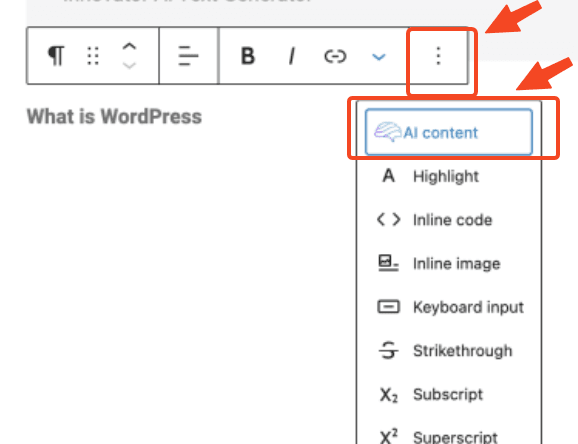
Use AI to Enhance SEO in the Most Effective Way
The finest application of AI tools is for growing SEO in a way that increases worker productivity. This generally entails delegating the laborious task of research and analysis to the AI.
Summarizing webpages to build a meta description may be an allowed usage, since Google expressly states that it is not prohibited.
It may be interesting to utilize ChatGPT to develop an overview or a content brief.
Giving content production to an AI and distributing it as-is may not be the most effective use of AI if it is not first vetted for quality, accuracy, and usefulness.


















